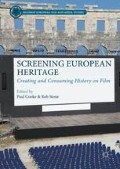Abstract
Since the beginning of the heritage cinema debate in the 1980s, the concept has proven enormously popular and, in the British context, virtually all period films made subsequently have been subsumed under this proliferating critical framework (Monk and Sargeant 2002: 11). That heritage cinema has emerged as such an attractive label is all the more surprising given that it has come under attack for promoting a class-biased, conservative and consensual notion of Englishness. The excessive pictorialism, museum aesthetics, and privileging of mise-en-scène, elaborate costumes and retro fashion over narrative has even provoked some derogatory comments from critics who have dubbed heritage cinema ‘the Laura Ashley school of filmmaking’, the ‘Merchant Ivory “Furniture Restoration” aesthetic’ and the ‘white flannel school’ (cited in Vincendeau 2001: xviii–xix). Perhaps the lively scholarly debates that have surrounded heritage cinema ever since Andrew Higson coined the term spring from the fact that it offers a ‘clear explanatory model [that] makes things look simple […] because it confers a pleasing symmetry onto the seeming chaos of cultural forms’ (Harper 2004: 140). The vibrant critical interest in heritage cinema coincides with the actual growth of this successful production trend. As Randall Halle notes, no other genre flourished as much during the 1990s, the decade when the European Union was founded, as the historical film. This simultaneity, he proposes, points towards a significant dialectical tension, ‘because typically the historical genre has been deployed within the national ensemble precisely as a vehicle for the imagining of the national community’ (Halle 2008: 90). It seems as if becoming part of a larger transnational community had stimulated a growing desire to be securely contained in the smaller community of the nation. The surge of heritage films since the 1990s thus reflects a certain nostalgia to be part of a specific national heritage.
Access this chapter
Tax calculation will be finalised at checkout
Purchases are for personal use only
Works Cited
Akomfrah, J. 2010. Chiasmus. An interview with John Akomfrah, bonus material. DVD The Nine Muses. New Wave Films.
Austin, G. 2009. ‘Seeing and listening from the site of trauma’: The Algerian War in contemporary memory. Yale French Studies 115: 115–125.
Berghahn, D. 2013. Far-Flung families in film: The diasporic family in contemporary European cinema. Edinburgh: Edinburgh University Press.
Bouchareb, Rachid. 2010. Interview de Rachid Bouchareb, cineaste de Hors-la-loi. Toutlaculture, 22 September.
———. 2011. Interview, bonus material of DVD release Outside the Law. Optimum Releasing.
Bourne, S. 2002. Secrets and lies: Black histories and black historical films. In British historical cinema, eds. C. Monk and A. Sargeant, 47–65. London: BFI.
Clark, A. 2014. Portrait of a Lady. Sight & Sound 24(7): 31–33.
Cooke, P. 2012. Contemporary German cinema. Manchester: Manchester University Press.
Donadey, A. 2014. Wars of memory: On Rachid Bouchareb’s Hors la loi. L’Esprit Créateur 54(4): 15–26.
Durmelat, S. 2012. Re-visions of the Algerian War of independence. In Screening integration: Recasting Maghrebi immigration in contemporary France, eds. S. Durmelat and V. Swamy, 93–111. Lincoln and London: University of Nebraska Press.
English Heritage. 2014. Kenwood story to be told on the big screen. English Heritage Members Magazine, 6 June.
Hall, S. 1999. Whose heritage? Unsettling ‘the heritage’, re-imagining post-nation. Third Text 49: 3–13.
———. 2003[1990]. Cultural identity and diaspora. In Theorizing diaspora: A reader, eds. J. Evans and A. Mannur, 233–246. Oxford: Blackwell.
Halle, R. 2008. German film after Germany: Towards a transnational aesthetics. Chicago: University of Illinois Press.
Harper, S. 2004. The taxonomy of genre: Historical, costume and ‘heritage’ film. Journal of British Cinema and Television 1(1): 137–142.
Higbee, W. 2013. Post-Beur cinema: North African Émigré and Maghrebi French filmmaking in France since 2000. Edinburgh: Edinburgh University Press.
Higson, A. 2006 [1993]. Re-presenting the national past: Nostalgia and Pastiche in the heritage film. In Fires were started: British cinema and Thatcherism, ed. L. D. Friedman, 2nd Rev edn, 91–109. London: Wallflower Press.
Jafaar, A. 2011. Algeria rising. Sight & Sound 21(6): 38–44.
Jameson, F. 1985. Postmodernism and consumer society. In Postmodern culture, ed. H. Foster, 111–125. London: Pluto Press.
Koepnick, L. 2002. Reframing the past: Heritage cinema and Holocaust in the 1990s. New German Critique 87: 47–82.
Monk, C., and A. Sargeant. 2002. Introduction: The past in British cinema. In British historical cinema, eds. C. Monk and A. Sargeant, 1–14. London: BFI.
National Archives. (n/d). [Online]. Available at: http://www.nationalarchives.gov.uk/pathways/blackhistory/intro/intro.htm. Accessed 4 Dec 2015.
Nora, P. 1989. Between memory and history: Les lieux de mémoire. Representations 26: 7–24.
Oscherwitz, D. 2010. French cinema and the post-colonial heritage. Carbondale and Edwardsville: Southern Illinois University Press.
Renan, E. 1990 [1882]. What is a nation?. In Nation and narration, ed. Homi K, Bhabha, 8–22. London and New York: Routledge.
Rosello, M. 2012. Rachid Bouchareb’s Indigènes: Political or ethical event memory. In Screening integration: Recasting Maghrebi immigration in contemporary France, eds. S. Durmelat and V. Swamy, 112–126. Lincoln and London: University of Nebraska Press.
Rushdie, S. 1991. Imaginary homelands: Essays and criticism. London: Granta.
Stora, B. 2014. Close-up: Postcolonial filmmaking in French-speaking countries. The Algerian War: Memory through cinema. Black Camera: An International Film Journal 1: 96–107.
Vidal, B. 2012. Heritage film: Nation, genre, representation. London: Wallflower Press.
Vincendeau, G. 2001. Introduction. In Film/literature/heritage, ed. Ginette Vincendeau, xi–xxiv. London: BFI.
Walvin, J. 2014. Historian at the movies: Belle reviewed. History Extra [Online]. Available at: http://www.historyextra.com/feature/international-history/historian-movies-belle-reviewed. Accessed 2 July 2015.
Author information
Authors and Affiliations
Corresponding author
Editor information
Editors and Affiliations
Copyright information
© 2016 The Author(s)
About this chapter
Cite this chapter
Berghahn, D. (2016). Rewriting History from the Margins: Diasporic Memory, Shabby Chic and Archival Footage. In: Cooke, P., Stone, R. (eds) Screening European Heritage. Palgrave European Film and Media Studies. Palgrave Macmillan, London. https://doi.org/10.1057/978-1-137-52280-1_5
Download citation
DOI: https://doi.org/10.1057/978-1-137-52280-1_5
Published:
Publisher Name: Palgrave Macmillan, London
Print ISBN: 978-1-137-52279-5
Online ISBN: 978-1-137-52280-1
eBook Packages: Literature, Cultural and Media StudiesLiterature, Cultural and Media Studies (R0)

